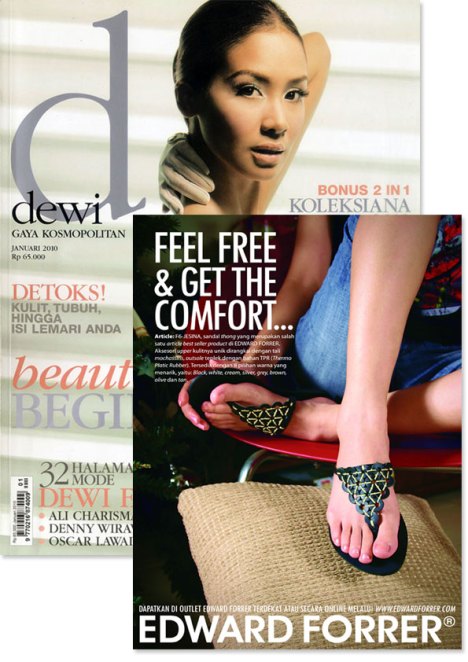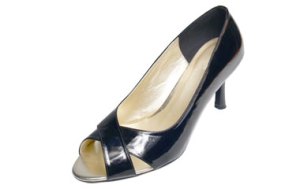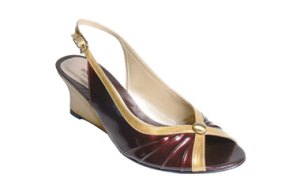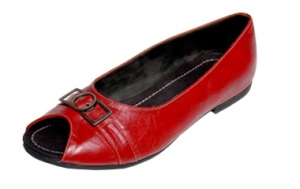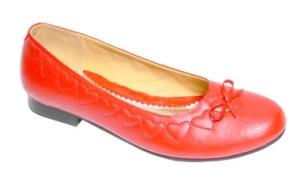Cleaning shoes has been a challenge for humans since we first covered our feet. White shoes are a particular problem, especially in the summer months when people are active. White shoes are made from a variety of materials and your cleaning method will depend on what material your shoes are made from. In this wikiHow we’ll examine the culture of shoe cleaning, and cobble together some advice for those who prefer not to buy new shoes every three months.
* If your shoes are not made of leather, follow these steps. Warning: Don’t do this with leather shoes or they will be ruined!
1. Assess the damage to your shoes. Are they muddy? Scuffed? Or just lightly soiled?
2. Get a good cloth and wrap around it around your hands like brass knuckles. use this to scrub away obvious dirt, mud and grime.
3. Wash the cloth with a liberal amount of soap. Rub the soap all over the white part of the shoes.
4. Get a stiff brush and brush all over the soap covered parts.
5. Wash the soap off with a clean cloth.
Suede shoes
1. Any leather shoe not made from smooth leather needs special cleaning techniques.
* Clean suede shoes using this method.
Canvas shoes
1. Clean canvas shoes by spot washing using a mild detergent and soft toothbrush.
2. Once clean, consider spraying canvas shoes with a “Scotchguard” type fabric protector. Test the spray on the tongue of the shoe to make sure it won’t stain.
Machine washing
* Some people wash their shoes in the washing machine. There are a few tips to remember:
1. Remove the laces and any other removable parts.
2. Use the warm, not hot, cycle.
3. Add regular detergent.
4. Either place the shoes in a bag with towels to protect your washing machine or just dump them in with a load.
5. Do not use the dryer as this will probably melt your shoes, destroy your dryer, or both. If you feel you must use the dryer use a very low heat and a protective bag.
6. Let the shoes air dry or use paper towels.
7. Note: even if the shoe is machine washable multiple washes can break down the adhesive that holds the shoe together.
Clean smooth white leather shoes
* Cleaning leather shoes is considerably more complicated. Leather is skin, and so most methods that clean skin will also clean leather. To complicate matters there are a vast set of choices in commercial leather cleaning products. Proper care for leather shoes involves more than cleaning, but also protecting and polishing the leather. To clean leather properly, determine which type of leather you have. The instructions here are for smooth leather.
Clean smooth leather with soaps.
1. Use a soft cloth to remove obvious dirt and dust from the surface of the shoe.
2. Remove the laces.
3. Rinse the shoes with warm, not hot, water, inside and out.
4. Prepare a solution of warm water and a ‘natural soap’. Common soaps for cleaning shoes include:
* Saddle soap is the most common choice.
* Liquid detergent like dish-washing liquid.
* Regular hand soap.
5. Use a soft brush and scrub every part of the shoe with the soap mixture.
* Do not scrub too hard or your could damage the surface of the leather.
* Remove scuff marks with a nylon backed brush, or wait until the conditioner is applied.
6. Rinse the shoes in warm water again, both inside and out.
7. Stuff your shoes with paper towels. The paper will absorb the water and make the drying process go faster.
* Replace the paper when it gets water logged.
* Do not use newspaper as the black ink can run and ruin your shoes.
* Stuffing your shoes with paper also helps them hold their shape as they dry.
8. Allow your shoes to drip dry.
Clean your shoes with commercial products
* Shoe cleaners come in gels, foams, sprays, liquids and creams. You can also use leather cleaning products designed for car seats.
1. Put your shoes and all materials on top of several layers of newspaper before you begin.
2. Remove any laces.
3. If your leather shoes have a lot of old polish buildup, you may want to use a pre-cleaner.
4. Read the directions on your leather cleaner.
5. Many leather cleaners come with an applicator top, or you can use a soft shoe brush.
6. Use the brush to rub the cleaner into any cracks and seams.
7. Remove the cleaner based on the packet instructions.
Leather shoe products
* There are many products on the market for cleaning leather shoes. Leather is leather, so any leather cleaner, be it for jackets or car seats, will also clean your leather shoes.
1. Shoe wipes can be bought all over and are great for spot cleaning. Some people also use Baby Wipes.
2. A Clorox Bleach Pen is used by many to spot clean white shoes, especially in seams and in stitching.
3. Clean-n-Brite is also used by many to safely clean white leather. You can visit website, there is a page about cleaning leather.
4. KIWI Sport Shoe Scrub-Off Heavy Duty Cleaner has good results.
5. A Magic Eraser, which you can buy in any art store, has also had good results in spot cleaning shoes.
6. Permatex DL Hand Cleaner is a product for cleaning skin that works well on almost all leather. You can find this product in hardware stores.
7. Goo Gone is an excellent cleaner, also often found in hardware stores. Follow the dilution directions on the packet and eventually Goo Gone will remove just about anything.
8. Goop waterless hand cleaner is another excellent hand cleaning product used by contractors to remove the harshest dirt from skin and as such is also a great leather cleaner. Goop also removes stubborn stains that other products may not reach, and thus is a good first treatment for very dirty shoes.
Condition your shoes
* Conditioning your leather shoes will help soften and moisturize the leather, and protect it from drying out and cracking.
1. Use a leather conditioner especially made for smooth leathers. Do not use a cleaner and conditioner in one product.
2. Use a ‘natural’ conditioner that absorbs into the material, not a synthetic conditioner.
* Some people use Mink Oil as shoe a conditioner.
3. Choose a conditioner that is the same color as your shoe.
* If you still see scratches or other imperfections choose a shoe conditioner in a shade one shade lighter than the color of your shoe.
4. To condition your shoes:
1. Rub a small amount of conditioner into the shoe using a clean cloth or applicator.,
2. Cover the entire shoe with conditioner.
3. Wait a few minutes.
4. Wipe the shoes free of any extra conditioner.
Polish your shoes
* An important stage in shoe cleaning is to polish your shoes. High-quality leather shoes should be polished at least once a month.
1. Choose the correct polish for your kind of shoe.
2. Choose the correct color of polish.
* If you wish you can use mutiple polishes: white for the white parts, black for the black.
3. Understand that shoe polishes come in four basic forms: waxes, pastes, liquids,and creams.
1. Creams and pastes add moisture to your shoe by soaking into the leathers as they work. Because they actually penetrate the surface of the leather, creams and pastes cover scratches and other imperfections. Creams and pastes work well on all types of shiny or smooth leathers.
2. Wax shoe polishes are good for protecting form the elements but do not treat the actual leather of your shoes.
3. Liquid shoe polish is easy to apply, but like wax, doesn’t penetrate or condition the leather.
4. Shoe polish paste is the longest lasting, but is very messy and slow to work with. Shoe polish cream is a great compromise, and is available in lots of colors.
4. To polish your smooth leather shoes:
1. Apply the polish to a small area of the shoe to make sure the color matches.
2. Rub the polish into the shoe with a soft clean, lint-free cloth.
3. Apply the polish in small, circular motions.
4. Be sure to get plenty of polish on any imperfections.
5. Allow the polish to dry.
6. Shine your shoes by buffing them with a soft cloth or brush made specifically for shining shoes.
Toxicity of shoe polish
* Commercial shoes polishes can contain potentially harmful chemicals. Even those products that claim to be free usually do not list their ingredients, so it is difficult to know for sure. If you are concerned about the safety of working with shoe polish there are some tips and alternatives you can consider.
1. The EPA (Enviromental Protection Agency) has identified a chemical called Perchloroethylene (PERC) that does not occur in nature. The largest US user of PERC is the dry cleaning industry, but it is also used in textile mills, chlorofluorocarbon producers, vapor de-greasing, metal cleaning operations, and the makers of rubber coatings. In commercial products PERC is often found in aerosols, solvent soaps, printing inks, adhesives, sealants, polishes, lubricants, typewriter correction fluid and shoe polish. PERC enters the body when breathed in with contaminated air or when consumed with contaminated food or water. It is less likely to be absorbed through skin contact. Once in the body PERC can remain for a long time, stored in fat tissue.
2. If you choose to use shoe polish always take precautions:
1. Wear gloves.
2. Use in a well-ventilated area.
3. Keep all polish out of the reach of children or animals.
4. Discard any rags or extra polish as you would dispose of other potentially harmful household chemicals.
3. If you would prefer not to use shoe polish consider one of the many folk solutions to polishing your shoes including the use of vegetable oil or petroleum jelly.
Folk Remedies
* Over the years keeping leather shoes clean has been a classic common sense problem, something that was important to a variety of people including soldiers and others in uniform, nurses and such, for hundreds of years. As a result there are many folk remedies for various stages of the leather shoe cleaning problem.
1. Westley’s Bleche-Wite whitewall/blackwall tire cleaner is reported by some to be an excellent leather shoe cleaner. Note: Tires are made form rubber, so this method may work better on rubber shoes.
1. Use a scrub brush and rinse the shoe with water.
2. Use a clean cloth to rub in the tire cleaner.
3. Rinse.
4. Note: tire cleaner does a great job getting that foam rubber between the boot and the sole white again.
2. Grease stains on leather can be treated with this method.
3. Toothpaste is used by many to clean their leather shoes.
1. Put a dab of toothpaste on a washcloth or old toothbrush.
2. Gently rub the stains with the toothpaste.
3. Rinse.
4. Mildew can be removed from leather shoes.
1. Mix:
* 1 cup of rubbing alcohol
* 1 cup of water.
2. Sponge the solution onto your shoes and work it into the leather well.
3. Allow to air dry.
4. Clean, condition, and polish.
5. Petroleum jelly is reported by some to be a good cleaner and protector for leather shoes.
1. Apply jelly to a smooth, clean, lint-free cloth.
2. Rub in the jelly using a circular motion.
3. Let them rest a little while.
4. Wipe off the jelly using a clean cloth.
6. The inside of a banana peel has been reported to work for smooth leather shoes.
1. Test in an inconspicuous area like the tongue of the shoe.
2. Rub the banana peel all over the shoe.
3. Clean with water and a clean cloth.
7. WD40 is used by some to clean and protect their leather work shoes.
1. Remove any obvious direct, mud or other debris.
2. Spray the shoes with WD40.
3. Gently buff using a lint-free cloth.
8. Furniture polish is used by some to keep thier leather shoes in good condition. This may not be the best solution for white shoes, but if you can find white furniture polish it may work.
1. Clean very dirty shoes with a household cleaner.
2. Spray the polish lightly over the shoe.
3. Wipe away any excess polish with a clean cloth. The polish helps seal in moisture so leather shoes don’t dry out and crack.
9. Olive oil or walnut oil may also clean and protect smooth leather.
1. Test the oil in an inconspicuous spot like the tongue of the shoe to ensure color fastness.
2. Work a small amount into shoe using a soft cloth.
3. Polish with a soft cotton cloth.
10. Use lemon juice to remove regular dirt spots from leather :
1. Mix:
* 1 part lemon juice
* 1 part cream of tartar
2. Work the paste into the spot with a soft cloth.
3. Let it sit for a few hours, if needed.
4. Come back and apply a little more paste.
5. Work it in and then wipe clean.
11. Ink spots can be removed in two ways:
* Dip a cotton swab into rubbing alcohol and rub the spot.
* Use a non-oily cuticle remover. (Note: That is “cuticle” remover, not nail-polish remover.) Leave it on overnight and wipe it off with a damp cloth.
12. Keep leather supple, use the following homemade mixture of vinegar and oil:
1. Mix:
* 1 part white vinegar
* 2 parts linseed oil
2. Pour the solution into a jar with a lid.
3. shake well and apply to the leather with a soft cloth.
4. Let it sit for 12 hours and buff.
5. If the cloth starts to soil, be sure to change it often.
13. Road salt can be removed from leather with a vinegar solution:
1. Mix:
* 1 part water
* 1 part white vinegar
2. Dip a soft cloth into the solution.
3. Blot the solution over the shoes to remove the salt. You may have to do this several times to clean the entire surface.
4. Rinse the shoes with clear water when you are done.
14. Water spots can be removed from leather by:
1. Moistening the area with a little water.
2. Let it dry or gently blow dry. Never place leather in the sun to dry.
15. VO5 hair conditioning gel is reported to be a good leather cleaner.
1. Remove most of the dust and obvious dirt with a damp cloth or brush.
2. Rub a little dab of gel over the surface and wipe with a soft cloth to a shine.
3. A little gel goes a long way, so don’t use too much.
[edit] Tips
* Leather should be kept out of direct sunlight.
* The next time you buy a pair of leather shoes, condition them before ever wearing them. This will help insure that your shoes are best protected from the start, and will save time on future cleanings.
Warnings
* Rags or clothes used that come in contact with the shoe polish should also be immediately discarded.
* Remember: When removing spots from leather, always test any cleaning method on an out-of-the-way spot first.
* Don’t try to use shoe polish to change the color of your shoes. If you need your shoe color changed, consult a shoe repair shop.
[edit] Things your will need
* Newspapers
* Gloves
* Soft Cotton Cloths or Rags
* Soft Shoe Brush (optional)
* Smooth Leather Shoe Cleaner
* Leather Conditioner for Smooth Leather Shoes
* Shoe Polish, or a Shoe Polish Alternative
* Leather protector (a Waterproofing Product)
* Laundry detergent
Filed under: Bags, Fashion, General, Sandals, Shoes | Tagged: Accesorries, Accessories, Bags, Edward Forrer, feet, female, footwear, Sandals, Shoes, Socks, store, style | Leave a comment »
 Edward Forrer Outlet Bandung 3
Edward Forrer Outlet Bandung 3








